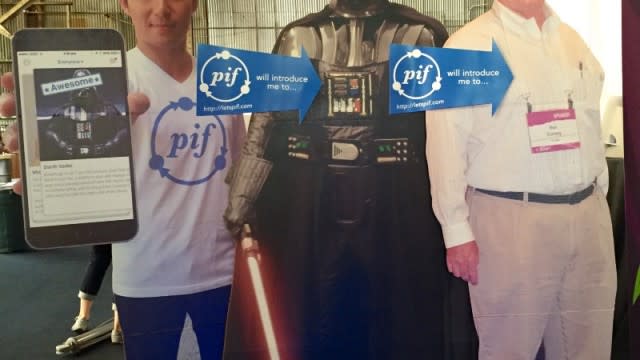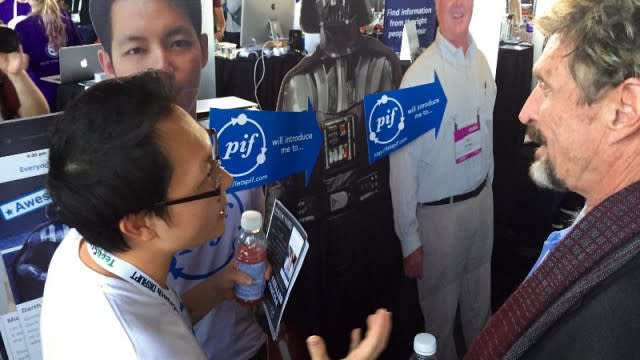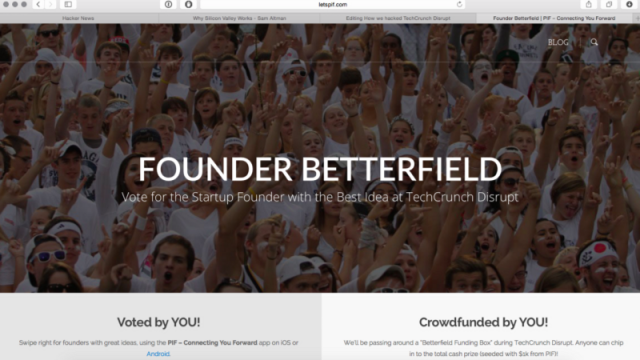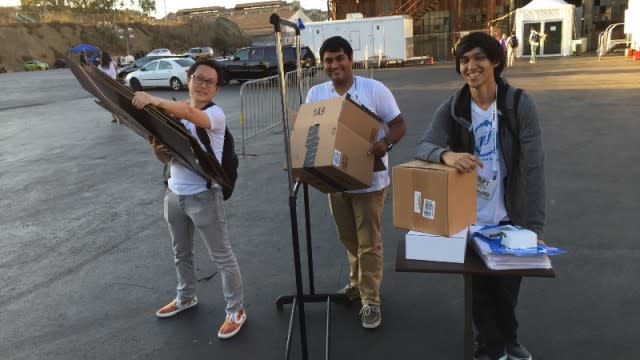How this Singapore startup hacked TechCrunch Disrupt
How can startups navigate the ‘fabled’ TechCrunch Disrupt, which many Asian startups regard as the Mecca of all tech conferences? This founder recounts his experience
The author Michael Cho is the Co-Founder and CTO of PIF, a Singapore startup that travelled to the US to attend TechCrunch Disrupt and launch its product. This article was first published on Medium.
Truth be told, neither of us had attended a major tech conference like TC Disrupt SF 2015 before. Our strongest reference point was probably Silicon Valley, the TV show (which turned out to be a fairly close depiction of the real thing).
Some quick background: We are a two-man startup with a brand new mobile app. We needed users to test out our MVP and some serious greenbacks to continue pursuing our vision.
Attending Disrupt SF 2015 meant spending US$2,000 for two three-day passes (we enrolled under the Startup Alley), and a small table as a booth spot that would last only for one day (out of the full three days).
On top of that, we would have to vie for attention alongside the other 400-or-so startups who were looking for the same things as we were. We had to figure out ways to cut above the noise, and this would mean a big gamble — time and money add up real quickly (we ended up spending close to US$6,000 in total).
We decided to give Disrupt SF 2015 a shot anyway, and launch our app there.
Was it worth it?
ABSOLUTELY! But only if you’re willing to work your ass off, think out of the box, embrace rejections and you get a good dose of luck and serendipity.
By the end of the third day, we had follow-up leads with a billionaire, a half-dozen top VCs and angel investors, TechCrunch writers and most importantly, real user feedback for our app.
We learnt a lot about what worked and what didn’t. And frankly, for things that worked, it was largely because of the kindness of others. So we thought it only right to share everything here and pay it forward to other dreamers like ourselves, who might benefit from hearing about our experience.
Who should read this?
Early-stage startup founders. The small guys.
If you’re like me and my Co-Founder (Kenneth) and you are deciding whether to skip lunch to print another 500 copies of your flyers for that tech conference you signed up for, this post is for you.
BIG DISCLAIMER: None of the following will amount to ANYTHING if, at the end of the day, you can’t build a product that users love. Frankly, we’re still trying to nail our own product-market fit too. I guess that is the only thing that matters in the end, not the hustling gimmicks that we’ll share with you below.
5 ways of the hustle (at a tech conference)
We will list “ways of the hustle” that worked well for us at Disrupt SF 2015. And we’ll give you specific anecdotes of what we actually did (or planned to do but didn’t end up doing) at Disrupt to illustrate our point.
So, let’s rock and roll!
1) Be Prepared!
We started planning for the three-day Disrupt conference way too late — about 4 weeks before the event. The hardest part of this was thinking of a way to really cut above the noise (more on this later) at Disrupt, and this had to be decided upon before any of the preparations discussed below could begin.
Theoretically, all the design and printing of marketing collaterals like flyers, namecards, t-shirts, etc. should take less than a week. But things almost always change, and Murphy’s Law tends to rear its ugly head.
For example, the printer we had been liaising with almost didn’t want to take our job because he was overwhelmed with another huge order (he finally did so, begrudgingly).
And if you’re planning on ordering custom-made materials, be sure to plan ahead, as they have differing (and typically long) lead times. We had custom balloons, custom cardboard cut-outs, as well as some custom-printed vinyl laptop stickers (that can turn your laptop into a small white board meant as giveaways) that were ordered and shipped over from China (a three-week process).
Also Read: 3 mistakes I made when I moved from Silicon Valley to Asia
Other preparations included getting our website and our social media presence (ie. Facebook, Twitter, etc.) sorted out. We also set up a MailChimp account and drafted email pitches to members of the tech press (TC will provide a press list a week before the event), and other startups attending Disrupt.
And of course, the app version that we bug-tested like crazy and submitted to the App Store three weeks before Disrupt still ended up being rejected due to a silly bug. We finally got a fixed version up on the App Store three days before Disrupt, after two expedited review appeals to Apple (more on this later)! Big hugs from us to the testers at Apple!
2) Recce the site!
This is actually a form of preparation as well, but it’s so important that it deserves its own discussion.

Kenneth and I during one of our recce trips. Loving the whole rustic look of Pier 70!
We’re based in Palo Alto, but we walked the ground at Pier 70 on three separate occasions prior to the event. We needed to be sure about certain topographic details (eg. “Where would our banners be most visible around the Pier 70 site, as opposed to the legality of putting them up?”)
We identified all the natural choke points for the footfall by figuring out where people would park their cars and the possible routes of entry for people driving or taking the Caltrain.
This proved to be useful, as we decided to set up “mobile booth spaces” at one of the choke points, handing out flyers to conference-goers strolling into Pier 70. This simple decision garnered significant mindshare among the folks at Disrupt, many of whom later told us things like, “Oh! So you’re the guys outside with the crazy signboards giving us flyers!”
Every memorable touch point goes a long way, especially when you typically have 60 seconds to pitch to someone!

We had another crazy idea that got us excited, but we weren’t able to pull it off because of budgetary constraints. We tried to work something out with the Pier 70 management folks, but were rejected outright and told to speak with TC instead.
We knew that TC wouldn’t give us any special treatment (unless we ponied up and became a sponsor i.e. big bucks), so we turned our focus to the building right next to the warehouse where Disrupt would be held.
It was a thing of beauty — big and tall, shared the same frontage, and provided an alternative for a “showpiece” banner.

The warehouse next to Pier 70. We wanted to put up 3 huge banners (marked in red boxes) with bait phrases like “Disrupting Disrupt by PIF” or “Who is PIF?”.
We felt like insurgents trying to gain access to the warehouse, but all inlets were blocked. Fortunately, we found a small note on one of the back gates that said “Emergency Contact: ….”
With that single lead, we got in touch with Hall Equities (the commercial real estate operator), who referred us to Orton Development (the owner of the other building next door), who then referred us to Forest City (the developer, but not the owner), who then referred us to the Port of San Francisco (the real owner! We’re getting close!), who finally referred us to the tenant who had leased that entire warehouse space. *Wipes sweat*
As it turned out, the tenant had already been approached by other startups offering as much as US$10,000 just to rent a small portion of the building wall for the three days. We finally gave up on that idea (Interestingly, we didn’t see any banners there during Disrupt. I suppose the deal fell through — and on hindsight, it was a blessing in disguise as the main entrance for Disrupt was in a location where our huge banner would’ve been rendered non-impactful anyway).
While the recce trips gave us a good sense of the site’s surrounding, we only got to know the actual layout of the conference on Day 1 itself, and had to improvise. And this is crucial if you want to get more than 60 seconds with that investor/journalist/influencer to pitch your idea.
The one journalist I really wanted to speak with was Jordan Crook, a Senior Writer at TC. I’d been following her articles over the years, and knew of her penchant for writing about the social/consumer space, which our app sits in (fun fact about Jordan: if you go to the TC site today, you’ll find that she has 155 pages of articles to her name, with each page having 20 articles; do the math).
Also Read: What you need to know before moving your startup to Silicon Valley
Knowing the layout and improvising on the fly soon came in handy. We figured out where the entry/exit points of the main stage and the nearest restrooms were. Jordan had to introduce the Disrupt speakers all day every day, so we knew she would hang out backstage, for the most part.
So I took my chance and waited at one of the exits (while everyone was inside and listening to the speakers) and Voila! She came out for a smoke break. I walked up to her and asked for 60 seconds of her time. She graciously agreed and listened to my pitch for a few minutes (I could’ve gone on for longer, given that it was just the two of us there, but I wanted to respect her personal space and time). She ended up referring me to her colleague, whom we’re now following up with (not sure if it’ll lead to an article yet, but it’s a start!).
So, know the ground well! Picking the right spot/time can mean the difference between never speaking to anyone and having a decent chat with the person you’ve been dying to connect with.
3) Think different!
I guess this goes without saying. And honestly, being creative about being different is hard. A good starting point though, is to think of what everyone will be doing and basically NOT do that.
Look at this picture below:

This is a scene from a typical Startup Alley day at TC Disrupt – you’ll see a multitude of startup booths consisting of a small round table, a tall stand-up banner (usually ~ 6″ tall) and a laptop or two.
We decided to NOT do any of those. No table, no laptop, no standup banner.
Here’s what we DID do:

The Force is strong with these Three!
We replaced all of that with life-sized cardboard figures of Darth Vader, Ron Conway (the legendary angel investor) and Kenneth holding a ginormous iPhone showing off our app.
It was a much more visual way of explaining how PIF works, which is basically a quid pro-quo method of connecting users to other users whom they want to meet . In this case, by allowing Kenneth to connect with him, Darth Vader (CEO of Dark Force Inc) then got the chance to be introduced to Ron Conway.
This was, by far, the single best hack that we pulled off at Disrupt! Throngs of people stopped to ask “What’s this?” while others posed for pictures with Vader and Ron. Even the John McAfee was impressed.

“Here’s my email. Do get back to me, I want to follow up with you guys.” — John McAfee
And of course, good things always come in pairs. So we had another identical set of Kenneth/Darth/Ron, but this time they were secured to a rolling clothes rack.
We pushed them all around the venue before we got chased out by security (exactly why the wheels made perfect sense). We then paraded the set around the perimeter of Pier 70, garnering more looks and interest along the way.
By the end of Day 1, we had people all over Disrupt talking about Vader, Ron, and PIF, which was exactly what we wanted.
Another area we tried to be different in was our business cards. We forwent conventional card design, and instead printed a screenshot of our personal profile in our app on our business cards. This provided yet another talking point about our app when exchanging business cards at Disrupt.
4) Create an event-specific campaign
Another way to cut above the noise is to create an event-specific campaign.
A good number of startups were giving out discounts that were applicable only to people who attended Disrupt. While that’s event-specific, we knew it’d be tough to stand out if we were one of the many others providing giveaways.
Since we had selected the startup community as the initial target user group for our app, we thought it’d be cool if anyone attending Disrupt could use our app to discover and vote for the startup founder with the best idea.
So we created the “Founder Betterfield” (for the uninitiated, TC organizes a “Startup Battlefield” contest at Disrupt to pick the best startup present; our contest name was just us being facetious, but we like it.

A site we cobbled together within a couple of hours to start spreading the word about our “side bet” to the Battlefield
To make it even more interesting, we decided to seed the prize money with some capital, and crowdfund the rest (beyond just crowdsourcing the winner). We walked around the Disrupt venue with an acrylic donation box and our seed capital inside and basically asked people to chip in (some really did)!
To sweeten the deal so that more founders would sign up, we made a deal with some leading Asia-based VCs who weren’t planning to be at Disrupt —for the simple act of creating a profile on our app, they would get the chance to discover and connect directly with interesting founders at Disrupt.
Also Read: Raising your seed round in Silicon Valley
We knew it’d be impossible to reach every startup founder on the day of the event itself, especially since they’d be busy promoting their apps, so we sent emails to all the startups attending Disrupt (we used Kimono to scrape the Disrupt webpage for email addresses and names) and told them about the Founder Betterfield. We managed to get some signups even before the event had begun.
In the end, though, the Founder Betterfield didn’t generate as much buzz as we had hoped for. While we got plenty of stares walking around with that box full of greenbacks, the number of signups was less than we had hoped for.
It’d be easy to blame it on our prize being insufficiently attractive, but the truth is organising a crowdsourced and crowdfunded campaign takes a lot of awareness building and promotion beforehand. Had we come up with the idea of the campaign sooner, and spent more time on drumming up participation in the contest, we would probably have seen better results.
Having said that, the contest proceeded as planned, and eventually a winner (John Kim of Jiver) was chosen by the people. We’re really glad that John has agreed to use the prize money towards purchasing Jiver’s services (basically an alternative to Layer) for another startup who is keen to use his service. This is very much in line with the pay it forward (thus the name PIF) ethos that our app embodies.
5) Get Helpers (w/o breaking the bank)
We’ve covered a lot of ground so far (and we’re not even half way through all our hacks!).
Clearly, Kenneth and I couldn’t possibly have pulled all of this off by ourselves. We knew we needed help to properly execute our plans.
Unfortunately, getting additional help for Disrupt is easier said than done. Even with the Startup Alley discount, adding team members would cost us almost US$1,000 per person. For a couple of bootstrapping startup founders, this was not a cost we were willing to bear.
So it was time for yet another hack: The student-interns.
Student tickets went for US$300 per person, a fraction of the startup alley price!
So we scouted for students at UC Berkeley and Stanford who were interested in startup work, and convinced them to skip class for a few days (and midterms!) to help us out at Disrupt, in return for a reimbursement of half of their ticket price.
Just like that, we got six extra “warm bodies” wearing our company t-shirt, and pitching our app and the Founder Betterfield contest to folks all around Disrupt. They were great help, and in particular, the three dudes we hired from UC Berkeley (Sunny, Vedant & Jon) were exceptional! They hustled like their life depended on it.

Me with Sunny & Vedant. Missing in this pic: Jon, Weili, Tze Yuan & Patrick. You guys were awesome!
Also Read: OTR: On whiteness, the Silicon Valley and Ahmed Mohamed
The post How this Singapore startup hacked TechCrunch Disrupt appeared first on e27.



